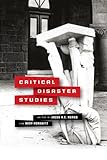Critical Disaster Studies / ed. by Jacob A.C. Remes, Andy Horowitz.
Material type: TextSeries: Critical Studies in Risk and DisasterPublisher: Philadelphia : University of Pennsylvania Press, [2021]Copyright date: ©2021Description: 1 online resource (304 p.) : 10Content type:
TextSeries: Critical Studies in Risk and DisasterPublisher: Philadelphia : University of Pennsylvania Press, [2021]Copyright date: ©2021Description: 1 online resource (304 p.) : 10Content type: - 9780812299724
- 363.34
- HV553
- online - DeGruyter
| Item type | Current library | Call number | URL | Status | Notes | Barcode | |
|---|---|---|---|---|---|---|---|
 eBook
eBook
|
Biblioteca "Angelicum" Pont. Univ. S.Tommaso d'Aquino Nuvola online | online - DeGruyter (Browse shelf(Opens below)) | Online access | Not for loan (Accesso limitato) | Accesso per gli utenti autorizzati / Access for authorized users | (dgr)9780812299724 |
Frontmatter -- Contents -- Introduction -- Introducing Critical Disaster Studies -- Part I. Knowing Disaster -- 1. The Voyage of the Paragon: Disaster as Method -- 2. Acts of God, Man, and System: Knowledge, Technology, and the Construction of Disaster -- 3. When Does a Crisis Begin? Race, Gender, and the Subprime Noncrisis of the Late 1990s -- Part II. Governing Disaster -- 4. Concrete Kleptocracy and Haiti’s Culture of Building: Toward a New Temporality of Disaster -- 5. Risk Technopolitics in Freetown Slums: Why Community- Based Disaster Management Is No Silver Bullet -- 6. Spaces at Risk: Urban Politics and Slum Relocation in Chennai, India -- 7. Plan B: The Collapse of Public- Private Risk Sharing in the US National Flood Insurance Program -- Part III. Imagining Disaster -- 8. Mediating Disaster, or A History of the Novel -- 9. The Tōkai Earthquake and Changing Lexicons of Risk -- 10. Translating Disaster Knowledge from Japan to Chile: A Proposal for Incompleteness -- Afterword -- “Acts of Men”: Disasters Neglected, Preventable, and Moral -- Notes -- Bibliography -- Index -- List of Contributors -- Acknowledgments
restricted access online access with authorization star
http://purl.org/coar/access_right/c_16ec
This book announces the new, interdisciplinary field of critical disaster studies. Unlike most existing approaches to disaster, critical disaster studies begins with the idea that disasters are not objective facts, but rather are interpretive fictions—and they shape the way people see the world. By questioning the concept of disaster itself, critical disaster studies reveals the stakes of defining people or places as vulnerable, resilient, or at risk.As social constructs, disaster, vulnerability, resilience, and risk shape and are shaped by contests over power. Managers and technocrats often herald the goals of disaster response and recovery as objective, quantifiable, or self-evident. In reality, the goals are subjective, and usually contested. Critical disaster studies attends to the ways powerful people often use claims of technocratic expertise to maintain power.Moreover, rather than existing as isolated events, disasters take place over time. People commonly imagine disasters to be unexpected and sudden, making structural conditions appear contingent, widespread conditions appear local, and chronic conditions appear acute. By placing disasters in broader contexts, critical disaster studies peels away that veneer.With chapters by scholars of five continents and seven disciplines, Critical Disaster Studies asks how disasters come to be known as disasters, how disasters are used as tools of governance and politics, and how people imagine and anticipate disasters. The volume will be of interest to scholars of disaster in any discipline and especially to those teaching the growing number of courses on disaster studies.
Mode of access: Internet via World Wide Web.
In English.
Description based on online resource; title from PDF title page (publisher's Web site, viewed 01. Dez 2022)


